Stock Market Short-term Overbought
Stock-Markets / US Stock Markets May 31, 2008 - 02:20 PM GMTBy: Mike_Burk
The good news is: The small cap indices hit new recovery highs last Friday.
Short Term : The market is over bought.
As of Friday all of the major indices were up for 4 consecutive days.
The chart below covers the past 6 months showing the S&P 500 (SPX) in red and an indicator showing the percentage of the last 4 trading days that were up in green. Dashed vertical lines have been drawn on the 1st trading day of the month.
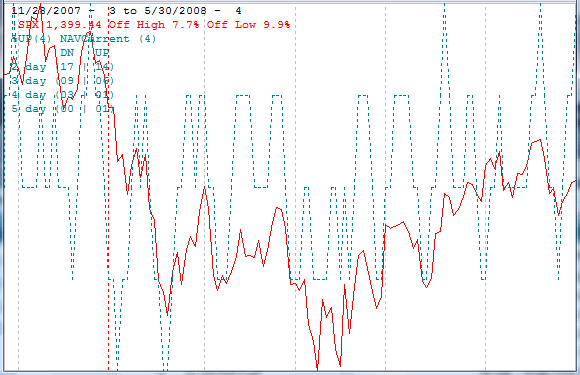
In the past 6 months each of the previous occurrences of 4 consecutive up days has been followed by a pull back.
Intermediate Term
New highs usually increase when the indices rise. That did not happen last week.
The chart below covers this year showing the SPX in red and a 10% trend (19 day EMA) of NYSE new highs (NY NH) in green. NY NH fell during last weeks rally.

The Russell 2000 (R2K) index rose over 3% to a new recovery high last week, but a new high indicator calculated from the component issues of the R2K did not.
The chart below covers this year showing the R2K in red and a 10% trend of R2K component issues hitting 6 week highs in green.
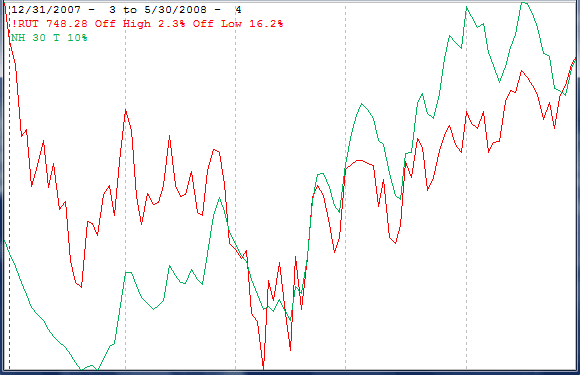
The blue chips did not do any better.
The next chart is similar to the one above except the index, in red, is the SPX and the indicator has been calculated from the component issues of the SPX.
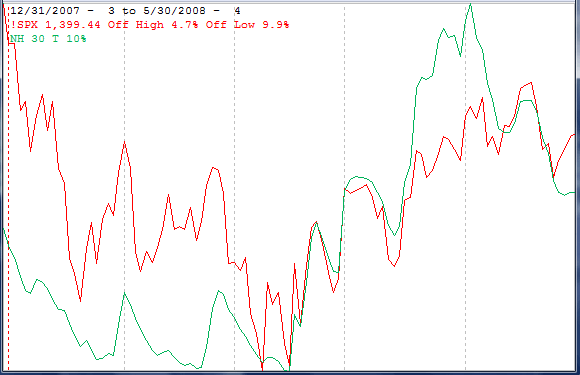
It is encouraging to see the small cap indices and indicators outperforming their large cap counterparts. But, with the indicators deteriorating, the intermediate term future does not look encouraging.
Seasonality
Next week includes the first 5 trading days of June during the 4th year of the Presidential Cycle.
The tables show the daily return on a percentage basis for the first 5 trading days of June during the 4th year of the Presidential Cycle. NASDAQ (OTC) data covers the period from 1963 – 2007 and SPX data from 1928 to 2007. There are summaries for both the 4th year of the Presidential Cycle and all years combined.
The huge gain in 2000 skews the OTC results positively.
The OTC has been up about 2/3 of the time and without 2000 the average OTC gain has been about 1%. The SPX has been up a little over ½ of the time with an average gain of about 0.5%.
First 5 days of June.
The number following the year represents its position in the presidential cycle.
The number following the daily return represents the day of the week;
1 = Monday, 2 = Tuesday etc.
| OTC Presidential Year 4 | ||||||
| Day1 | Day2 | Day3 | Day4 | Day5 | Totals | |
| 1964-4 | -0.08% 1 | -0.15% 2 | -0.10% 3 | -0.10% 4 | -0.49% 5 | -0.92% |
| 1968-4 | 0.87% 1 | 0.69% 2 | 1.06% 3 | 0.32% 4 | 1.14% 5 | 4.08% |
| 1972-4 | 0.45% 4 | 0.29% 5 | -0.58% 1 | -0.56% 2 | -0.76% 3 | -1.15% |
| 1976-4 | -0.26% 2 | 0.40% 3 | 0.11% 4 | -0.58% 5 | -0.60% 1 | -0.93% |
| 1980-4 | -0.19% 1 | -0.17% 2 | 0.86% 3 | 0.66% 4 | 0.31% 5 | 1.48% |
| 1984-4 | 1.32% 5 | 1.21% 1 | -0.13% 2 | 0.44% 3 | 0.17% 4 | 3.01% |
| Avg | 0.44% | 0.49% | 0.26% | 0.06% | 0.05% | 1.30% |
| 1988-4 | 1.21% 3 | -0.04% 4 | 0.59% 5 | 0.77% 1 | -0.11% 2 | 2.41% |
| 1992-4 | 0.52% 1 | 0.14% 2 | 0.13% 3 | -0.28% 4 | -0.48% 5 | 0.02% |
| 1996-4 | -0.38% 1 | 0.40% 2 | 0.44% 3 | -1.34% 4 | -0.22% 5 | -1.09% |
| 2000-4 | 5.34% 4 | 6.45% 5 | 0.22% 1 | -1.71% 2 | 2.21% 3 | 12.50% |
| 2004-4 | 0.20% 2 | -0.09% 3 | -1.44% 4 | 0.94% 5 | 2.12% 1 | 1.73% |
| Avg | 1.38% | 1.37% | -0.01% | -0.33% | 0.70% | 3.11% |
| OTC summary for Presidential Year 4 1964 - 2004 | ||||||
| Averages | 0.82% | 0.83% | 0.10% | -0.13% | 0.30% | 1.92% |
| % Winners | 64% | 64% | 64% | 45% | 45% | 64% |
| MDD 6/7/1972 1.89% -- 6/6/2000 1.71% -- 6/7/1996 1.55% | ||||||
| OTC summary for all years 1963 - 2007 | ||||||
| Averages | 0.28% | 0.36% | 0.18% | 0.05% | 0.11% | 0.97% |
| % Winners | 61% | 71% | 60% | 56% | 53% | 64% |
| MDD 6/7/2002 4.97% -- 6/6/1967 3.90% -- 6/7/2006 3.07% | ||||||
| SPX Presidential Year 4 | ||||||
| Day1 | Day2 | Day3 | Day4 | Day5 | Totals | |
| 1928-4 | 0.35% 5 | 0.75% 6 | -2.00% 1 | 0.25% 2 | -0.96% 3 | -1.61% |
| 1932-4 | -1.57% 3 | 2.00% 4 | 2.00% 5 | 2.00% 6 | -2.00% 1 | 2.43% |
| 1936-4 | -0.07% 1 | 0.00% 2 | -0.35% 3 | -1.46% 4 | -0.07% 5 | -1.95% |
| 1940-4 | -0.43% 6 | -1.30% 1 | 1.32% 2 | -1.52% 3 | 1.43% 4 | -0.50% |
| 1944-4 | -0.32% 4 | -0.08% 5 | 0.08% 6 | -0.65% 1 | 0.65% 2 | -0.32% |
| Avg | -0.41% | 0.27% | 0.21% | -0.28% | -0.19% | -0.39% |
| 1948-4 | 0.30% 2 | 0.12% 3 | -0.24% 4 | -0.78% 5 | -0.30% 1 | -0.90% |
| 1952-4 | -0.25% 1 | -0.08% 2 | 0.71% 3 | 0.63% 4 | 0.66% 5 | 1.67% |
| 1956-4 | 0.84% 5 | 0.59% 1 | 0.02% 2 | -0.50% 3 | 0.79% 4 | 1.74% |
| 1960-4 | 0.11% 3 | 0.43% 4 | 0.18% 5 | 1.17% 1 | 0.95% 2 | 2.84% |
| 1964-4 | -0.32% 1 | -0.51% 2 | -0.26% 3 | -1.03% 4 | 0.44% 5 | -1.69% |
| Avg | 0.13% | 0.11% | 0.08% | -0.10% | 0.51% | 0.73% |
| 1968-4 | 1.33% 1 | 0.39% 2 | -0.49% 3 | 0.76% 4 | 0.62% 5 | 2.61% |
| 1972-4 | 0.15% 4 | 0.04% 5 | -0.83% 1 | -0.56% 2 | -0.52% 3 | -1.72% |
| 1976-4 | -0.33% 2 | 0.37% 3 | -0.09% 4 | -0.98% 5 | -0.52% 1 | -1.55% |
| 1980-4 | -0.43% 1 | -0.23% 2 | 1.90% 3 | 0.15% 4 | 0.37% 5 | 1.77% |
| 1984-4 | 1.79% 5 | 0.72% 1 | -0.45% 2 | 0.89% 3 | -0.06% 4 | 2.88% |
| Avg | 0.50% | 0.26% | 0.01% | 0.05% | -0.02% | 0.80% |
| 1988-4 | 1.73% 3 | -0.51% 4 | 0.42% 5 | 0.23% 1 | -0.70% 2 | 1.16% |
| 1992-4 | 0.47% 1 | -0.91% 2 | 0.26% 3 | -0.32% 4 | 0.05% 5 | -0.45% |
| 1996-4 | -0.22% 1 | 0.73% 2 | 0.87% 3 | -0.80% 4 | 0.04% 5 | 0.63% |
| 2000-4 | 1.99% 4 | 1.97% 5 | -0.66% 1 | -0.67% 2 | 0.93% 3 | 3.56% |
| 2004-4 | 0.05% 2 | 0.34% 3 | -0.74% 4 | 0.52% 5 | 1.60% 1 | 1.76% |
| Avg | 0.80% | 0.32% | 0.03% | -0.21% | 0.38% | 1.33% |
| SPX summary for Presidential Year 4 1928 - 2004 | ||||||
| Averages | 0.26% | 0.24% | 0.08% | -0.13% | 0.17% | 0.62% |
| % Winners | 55% | 60% | 50% | 45% | 60% | 55% |
| MDD 6/6/1928 2.69% -- 6/4/1964 2.12% -- 6/6/1932 2.00% | ||||||
| SPX summary for all years 1928 - 2007 | ||||||
| Averages | 0.05% | 0.15% | 0.14% | 0.12% | 0.03% | 0.48% |
| % Winners | 51% | 62% | 54% | 53% | 51% | 59% |
| MDD 6/6/1930 3.96% -- 6/2/1931 3.58% -- 6/7/2002 3.24% | ||||||
Money supply (M2)
The chart below was supplied by Gordon Harms. After a bulge in March, money supply growth has fallen back to the elevated trend than began in late 2006. Declining money supply growth is usually not good for the stock market.
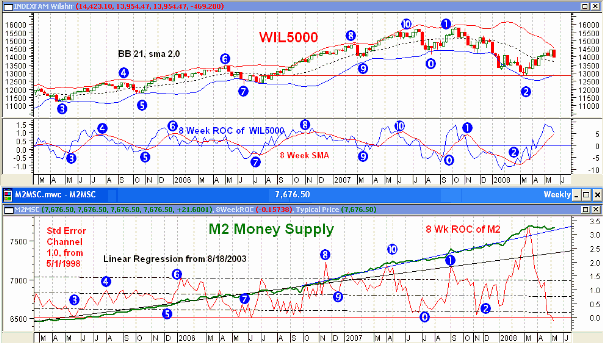
June
Over all years the OTC has been up 53% of the time with an average gain of 0.5%. That makes it the 10th strongest month of the year, ahead of February and July. During the 4th year of the Presidential Cycle the OTC has been up 73% of the time with an average gain of 1.8% putting it in a tie with September and November as the strongest month of the year.
The chart below shows an average June for all years in blue and the 4th year of the Presidential Cycle in green. The average month has 21 trading days. The chart has been calculated by averaging the return of the 1st 11 trading days of the month and the last 10. Dashed vertical lines have been drawn on the 1st trading day of the month and at 5 trading day intervals after that. The line is solid on the 11th trading day, the dividing point.
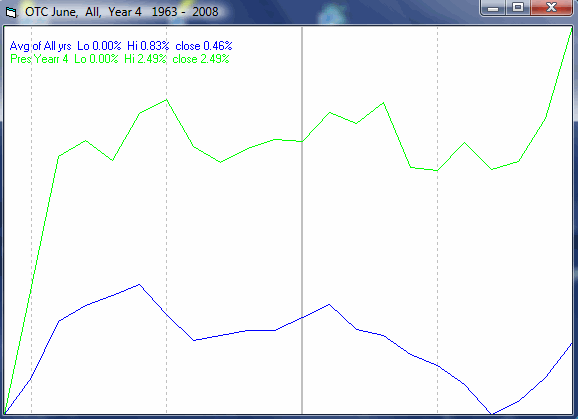
Over all years the SPX has been up 54% of the time with an average gain of 1.0% making June the 5th strongest month of the year. During the 4th year of the Presidential Cycle the SPX has been up 74% of the time with an average gain of 1.7% making June the strongest month of the 4th year.
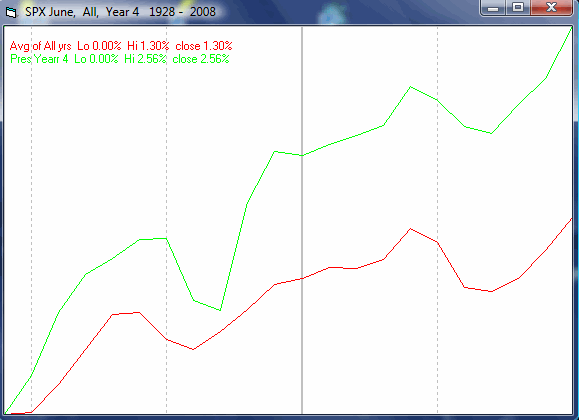
Conclusion
The market is over bought but seasonally next week has a positive bias.
I expect the major indices to be lower on Friday June 6 than they were on Friday May 30.
By Mike Burk
To subscribe to this report : http://alphaim.net/signup.html
Gordon Harms produces a Power Point for our local timing group. You can get a copy of that at: http://www.stockmarket-ta.com/ .
Disclaimer: Mike Burk is an employee and principal of Alpha Investment Management (Alpha) a registered investment advisor. Charts and figures presented herein are believed to be reliable but we cannot attest to their accuracy. Recent (last 10-15 yrs.) data has been supplied by CSI (csidata.com), FastTrack (fasttrack.net), Quotes Plus (qp2.com) and the Wall Street Journal (wsj.com). Historical data is from Barron's and ISI price books. The views expressed are provided for information purposes only and should not be construed in any way as investment advice. Furthermore, the opinions expressed may change without notice.
Mike Burk Archive |
© 2005-2022 http://www.MarketOracle.co.uk - The Market Oracle is a FREE Daily Financial Markets Analysis & Forecasting online publication.



